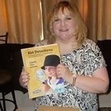Kim Caise's Blog, page 16
January 30, 2015
TCEA 2015 – Here I Come! Find out when and where!
 Are you going to TCEA 2015 next week? If so, please join me in the Digital Square hosted by Scott Floyd from White Oak School District on Wednesday, February 4th at 10am. I will talking about #makereducation and #makerspaces. I will also be giving away several books about helping create #makerspaces or #makered learning activities for your students. Come #learnanywhere and share your ideas or learn some new thing about #makereducation and #makerspaces!
Are you going to TCEA 2015 next week? If so, please join me in the Digital Square hosted by Scott Floyd from White Oak School District on Wednesday, February 4th at 10am. I will talking about #makereducation and #makerspaces. I will also be giving away several books about helping create #makerspaces or #makered learning activities for your students. Come #learnanywhere and share your ideas or learn some new thing about #makereducation and #makerspaces!


January 29, 2015
K-3 Student Writers – Ready to Write to Win?
I received an email today about a new PBS contest today. The details are as follows:
The Writers Contest is designed to promote the advancement of children’s literacy skills through hands-on, active learning. The contest is open to children in grades K-3 and encourages creative thinking and storytelling, while building literacy skills through the creation and illustration of original stories.
To enter, kids can submit stories to their local stations, and local winners will then be entered into the national contest. National winners will be announced during the summer of 2015, and the winning stories will be featured on pbskids.org/writerscontest.
This year, the judges include acclaimed writers, producers and children’s media creators, including Marc Brown, author and illustrator of the ARTHUR book series, and the Kratt Brothers, Martin and Chris, from the PBS KIDS show WILD KRATTS. The national winners will receive prize packages including ARTHUR books and a personal technology device courtesy of PBS.
January 12, 2015
All it Takes is One – Do you Agree?
 I have been working on a special project where I score educator’s compositions in response to a posed question. For the majority of the responses, I do not know where, what level or content area the educators teach. It is amazing how much information you can gather as to the type of educator the author of the response is.
I have been working on a special project where I score educator’s compositions in response to a posed question. For the majority of the responses, I do not know where, what level or content area the educators teach. It is amazing how much information you can gather as to the type of educator the author of the response is.
I can tell if they are a caring, compassionate educator from the written compositions that as well as educators who aren’t as dedicated to their students. Granted it could just be baloney in the responses or the writing style but fortunately most of the responses are very positive and the educators give evidence as to their positive teaching style and practice in the classroom. Granted I don’t know for sure but the comments appear to be good indicators as to how the educator feels about their students.
When I taught fourth and fifth grade, we always said we could predict which student was going to join a gang or drop out and who was going to be successful in their academic career. Were we right every time? No, we probably weren’t.
For those on the wrong track, what was the deciding factor if they continued down the wrong path or changed directions and began to exhibit successful traits? The intervention of a caring teacher. Some students truly do not realize their potential or want to put forth the effort to be successful.
Research shows that when a caring adult intervenes in a child’s academic path and performance, success can result. All it takes is one teacher to step in and encourage a student that is heading towards gang activity, drug or alcohol abuse, or has given up on school.
When I taught sixth grade, I saw numerous students turn around because one of the three teachers of the team I was on intervened. It didn’t take a great deal of time, usually an encouraging private conversation and praise in class. Sometimes we have to search for something good to praise students for but the effort in making a positive difference in the lives of our students is worth it. As Angela Maiers shares with educators and students, “You Matter!” Letting students know they matter can make all the difference and cause a student to see things differently and take a different life path. It can be very simple – one conversation with one student and praising a student one time. All it takes is one.
What are your thoughts? Please weigh in in the comments below. I welcome your thoughts and feedback.


January 7, 2015
Writer’s Block – How do you Break Through?
There are many times when a book or blog author runs into writer’s block and is unsure or totally blocked about that to write about next. I have the manuscript for a second book that needs to be finalized and I have been struggling with writing blog posts so I am stuck on both accounts. For those authors that have experienced this, what are some techniques that you use to break through and begin writing again? I try to read other blogs, newspapers, books, etc. to gather topics that move me and that I want to explore further via reading or writing. I would love to know what you do when you feel blocked? Please take a moment to leave a comment and let me know your thoughts and how you overcome writer’s block!


December 26, 2014
New MIT Video Series – FREE STEM Content
MIT shares that it has ‘gone into the movie making business’. The university’s Teaching and Learning Laboratory recently produced and released 47 “STEM Concept Videos” with a Creative Commons license that allows educators to view and share the recently created and released videos in the classroom. They are also part of the school’s website through its OpenCourseWare website. Any educator is able to use the videos to teach complex engineering concepts and written authorization is not necessary in this context.

MIT STEM Video Series
December 24, 2014
10 Essential Traits of Effective Educators – Paychecks of the Heart
Effective educators are effective for a reason. Whether the educator teachers online or offline, effective educators contain 10 traits that make them successful. When you see an effective educator in action, you will see the following traits in action as well.
1. Effective educators know their content and continue to learn new things in their content area. They are life long learners and are not afraid to say they don’t know something and know just where to go to find the information they are lacking. This could be an online resource, colleague or someone from their own personal learning network.
2. Effective educators take learning risks and create an environment where students feel comfortable doing the same. Asking questions of the teacher in front of the class or answering a question posed to the class and risking getting it wrong are encouraged and students aren’t afraid to take those risks. Students know that failure means a First Attempt at Learning and aren’t embarrassed if failure happens in the classroom.
3. Reflection upon lessons and a determination is made about what went well and what needs to be changed or eliminated. Reflection is a natural part of the learning and teaching process for effective educators.
4. Consistency is key to success. Consistency with rules, procedures, and routines is essential to a positive climate in the classroom. Teaching styles and lesson implementation can vary but the foundational principles and expectations must be consistent.
5. Lesson styles vary when delivering course content. Technology, science probes or a variety of things are incorporated to differentiate learning and meet the different learning styles of the students.
6. Classroom climate cultivates and reflects mutual respect and dignity. Student to teacher and student to student interaction is positive and respect is modeled and practiced.
7. Flexibility and organization are two traits that are apparent and students are guided in how to organize themselves according to their personality and learning styles. Organization is extremely important to success and effective educators model organization strategies and are flexible enough to be able to reach a variety of students’ needs.
8. Effective educators employ strategies to include parents, the community and a variety of educational stakeholders in the lessons and events occurring in the classroom.
9. Teaching course content is enjoyable and rewarding to effective educators. They enjoy what they teach and have limited misbehavior or discipline issues. Behavior problems are lessened when learning activities are hands-on, interesting, engaging and meaningful to the students.
10. Effective educators connect and collaborate with other educators to learn and share teaching ideas, strategies and resources. Effective educators know when to reach out to share strengths or seek help for a weakness and strive to increase the learning potential of each student in the classroom.
Truly effective educators are a rare breed. Student achievement in their classrooms are phenomenal and top the charts. Effective educators are not perfect with perfect students but the negative issues are greatly outweighed by the positive things happening in the classroom. Effective educators strive for greatness not for the monetary paycheck, but for paychecks of the heart by seeing their students achieve their maximum potential.
What other traits do effective educators exhibit that I did not include? I would love to hear how you earn ‘paychecks of the heart’ from your students!


10 Essentials Traits of Effective Educators – Paychecks of the Heart
Effective educators are effective for a reason. Whether the educator teachers online or offline, effective educators contain 10 traits that make them successful. When you see an effective educator in action, you will see the following traits in action as well.
1. Effective educators know their content and continue to learn new things in their content area. They are life long learners and are not afraid to say they don’t know something and know just where to go to find the information they are lacking. This could be an online resource, colleague or someone from their own personal learning network.
2. Effective educators take learning risks and create an environment where students feel comfortable doing the same. Asking questions of the teacher in front of the class or answering a question posed to the class and risking getting it wrong are encouraged and students aren’t afraid to take those risks. Students know that failure means a First Attempt at Learning and aren’t embarrassed if failure happens in the classroom.
3. Reflection upon lessons and a determination is made about what went well and what needs to be changed or eliminated. Reflection is a natural part of the learning and teaching process for effective educators.
4. Consistency is key to success. Consistency with rules, procedures, and routines is essential to a positive climate in the classroom. Teaching styles and lesson implementation can vary but the foundational principles and expectations must be consistent.
5. Lesson styles vary when delivering course content. Technology, science probes or a variety of things are incorporated to differentiate learning and meet the different learning styles of the students.
6. Classroom climate cultivates and reflects mutual respect and dignity. Student to teacher and student to student interaction is positive and respect is modeled and practiced.
7. Flexibility and organization are two traits that are apparent and students are guided in how to organize themselves according to their personality and learning styles. Organization is extremely important to success and effective educators model organization strategies and are flexible enough to be able to reach a variety of students’ needs.
8. Effective educators employ strategies to include parents, the community and a variety of educational stakeholders in the lessons and events occurring in the classroom.
9. Teaching course content is enjoyable and rewarding to effective educators. They enjoy what they teach and have limited misbehavior or discipline issues. Behavior problems are lessened when learning activities are hands-on, interesting, engaging and meaningful to the students.
10. Effective educators connect and collaborate with other educators to learn and share teaching ideas, strategies and resources. Effective educators know when to reach out to share strengths or seek help for a weakness and strive to increase the learning potential of each student in the classroom.
Truly effective educators are a rare breed. Student achievement in their classrooms are phenomenal and top the charts. Effective educators are not perfect with perfect students but the negative issues are greatly outweighed by the positive things happening in the classroom. Effective educators strive for greatness not for the monetary paycheck, but for paychecks of the heart by seeing their students achieve their maximum potential.
What other traits do effective educators exhibit that I did not include? I would love to hear how you earn ‘paychecks of the heart’ from your students!


Crazy for Brainzy – Get a FREE Membership! (More Codes on the Way!)
Note: 10 new codes will be coming next week so I will distribute those to the first 10 including those that asked after I ran out of the initial 10 below. No need to request a code again – I will go in order of the comments posted below on this post! Thanks Santa and Brainzy for your holiday generosity!
Kim
December 14, 2014
Connect with Santa using Technology
It’s time for my yearly ‘connect with Santa’ blog post! This is a great time of year if you have little ones that are eagerly
December 8, 2014
MIT STEM Video Project – Free Videos
MIT shares that it has ‘gone into the movie making business’. The university’s Teaching and Learning Laboratory recently produced and released 47 “STEM Concept Videos” with Creative Commons licenses that allow educators to view and share the videos in the classrooom. They are also part of the school’s website through its OpenCourseWare website. Any educator is able to use the videos to teach complex engineering concepts and written authorization is not necessary in this context.
The videos cover themes that are geared toward first and second year engineering students but many high school students could benefit from the catalog of videos. The video topics include engineering curricula such as, “…problem solving, communications, probability and statistics, equilibrium and nine other broad categories.”
The content for each short video was thoroughly vetted with talented faculty and authors for the video scripts. Each video is less than 15 minutes and feature animations, visualizations, demonstrations and a variety of other kinds of examples to help student viewers understand the concepts presented in the videos. You can be assured the quality and content presented are top notch as a result of their detailed concept approval method.
The Teaching and Learning Laboratory worked with faculty to develop the instructional practices featured in the video. The video series was initiated by the Singapore University of Technology and Design which collaborated with MIT to produce the video series.
The Teaching and Learning Laboratory (Lab) used the backward design process and developed the video with the end in mind. The Lab worked with course instructors from the foundational courses of the engineering curriculum. It identified selected learning outcomes and what was deemed as “pivotal concepts”, critical skills that supported the learning objectives and outcomes for each video. The pivotal concepts that served as the foundation for the videos met two essential criteria: the concepts were multidisciplinary and could serve as prerequisites for several concepts that would be taught in upper level undergraduate engineering courses. If the concepts did not meet the criteria, the concepts were not made into a video.
Once the pivotal concept was determine, the Lab assigned a primary author responsible for reviewing the videos created. A design team consisting of the Lab primary author, in conjunction with practicing engineers, brainstormed and developed ideas to help students visualize the concepts presented in the video. Each video was thoroughly review and the narration recording and supporting visuals were heavily scrutinized for content and quality.
Professor John Lienhard shared, “The resulting videos are a concise overview of challenging material.” If you have a flipped classroom or teach the advanced concepts presented in the videos, these resources would be excellent to explain and demonstrate concepts to students can conceptualize the complexities of engineering curricula.
Cross posted at http://elearningindustry.com/new-mit-....






